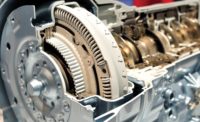One of the most essential issues in the semiconductor industry is the fabrication and the subsequent implementation of integrated circuits (ICs) with enduringly smaller feature sizes. The manufacturing of circuits with continuous shrinking critical dimensions (CD), not only expands the existing applications of semiconductors but also propels the demand for designs at the nanoscale level in the respective markets. However, they simultaneously call for novel apparatuses that need to cope with metrology requirements including high resolution, accuracy, and cost-effective precision. The traditional metrology tools such as CD-SEM, scatterometry, and optical lithography have proved to be inadequate and inaccurate at such low scales. Therefore, there has been a need for developing new, refined, and easy-to-use apparatuses that will ultimately overcome the intrinsic limitations of the existing metrology techniques. This article unfolds the principles of the new Park 3D atomic force microscopy (AFM) developed by Parks Systems. It is based on Park’s unique AFM architecture with independent flexure XY scanner and Z rotating head, its True Non-Contact™ technology and advanced electronics which allows for the acquisition of high-resolution images of sidewalls and undercut features.
Existing Metrology Tools and Their Limitations
The major technological necessity in the semiconductor industry is the development of circuits that have been shrinking critical dimensions continuously. Consequently, the respective metrology requirements for the development of such advance nodes need to be strict, and focus on precision, enhanced accuracy, and high resolution. Hence, the characterization of various parameters such as the Line Edge Roughness (LER), Line Width Roughness (LWR) and Sidewall Roughness (SWR) is of upmost importance due to the fact that they underline and define the device performance.
The current metrology tools cannot keep pace with the challenges imposed by lowering the CDs. Optical lithography was initially used for the creation of patterns in the manufacturing of semiconductors. However, as the dimensions of the circuits get smaller, this technique is limited in resolution. Moreover, an additional apparatus for measuring such parameters involves the scanning electron microscope (SEM). This method can provide automation and compatibility with low critical dimensions. However, it cannot offer the user with the acquisition of high resolution LER data (its resolution reaches it limits). Therefore, the demand for an innovative and cost-effective system that can fully characterize all critical parameters while it can simultaneously image all surfaces of the pattern has emerged.
Park Systems Non Contact 3D AFM and Its Innovative Features
The basic principle of Park non-contact 3D-AFM is that the cantilever rapidly oscillates just above the surface of the sample under investigation. One of its unique features is the implementation of an independent Z-scanner that is decoupled from the respective XY scanner. Therefore, and by using a very high performing Z-servo feedback, this method deters any physical contact between the surface of the sample and the tip of the cantilever (true non-contact AFM). In fact, the mechanical response of the Z-scanner must be very fast to track the respective changes (tip-sample interactions) and, hence prevent the tip from contacting the sample surface.
Furthermore, the implementation of the independent Z scanner offers the advantage of incredibly high Z-linearity while at the same time improving its Z-scan bandwidth.
Non-contact 3D-AFM is based on crosstalk elimination (non-destructive images that are free of artifacts) and can ensure accurate measurements of the critical dimensions of top, middle, and bottom photoresist lines while at the same time performing roughness measurements along their sidewalls. The Z-scanner can be intentionally tilted at a certain angle in order to gain access to the sidewalls of the material as depicted in Figure 4. Hence, the combination of three scans, each one performed at a predefined angle (typically 0º, a, and -aº) allows for the reconstruction of the full 3D pattern as depicted in Figure 5.
Results Obtained from
the CEA-LETI Test
Very low noise levels
One of the most important issues in semiconductor industry is the confinement of noise levels to a minimum during the manufacturing process. Therefore, the assessment of noise level in real environment is extremely important in order to fully exploit the capabilities of the technology under investigation. A study using a 300 mm wafer showed that 3D-AFM could limit the overall noise levels down to less than 0.05 nm at every position with a typical RMS of 0.02~0.03 nm.
Excellent roughness (SWR) measurements
Roughness measurements can essentially describe and determine the quality of the patterns. Therefore their subsequent evaluation is extremely critical for the performance of the apparatus. The Non-contact 3D-AFM provided excellent accuracy and repeatability in terms of Sidewall Roughness Measurements (SWR). Figure 7 illustrates a 3D-AFM image of a photoresist semi-dense line pattern imaged with Z-scanner tilt, whereas the bottom figure clearly shows the grainy structure of its sidewall. The SWR was approximately 6.0 nm which was validated with high repeatability (0.08 nm 1 σ for 5 sites wafer mean).
Critical Dimensions results
Studies were performed with CDs ranging from 50 to 200 nm in terms of bottom, middle, height and sidewall measurements. These measurements were then compared to the flared tip technology (Insight tool). The acquired results on resist lines validated that tilt 3D-AFM provides extremely higher accurate measurements for CD parameters, even within dense structures as shown in Figure 8.
The study also proved that there was a minimum tip wear following the acquisition of 150 consecutive images. Furthermore, the study showed that we could obtain almost the same profile in both tilt angles (difference of less than 0.13 nm) (Figure 9). Finally, we were able to succeed a CD measurements precision that reached 3σ from 4 Å up to 1.2 nm.
Conclusions
All things considered, this paper clearly demonstrates that Park non-contact 3D-AFM proves to be a leading, innovative, non-destructive, and cost-effective technology that has overcome the disadvantages of the conventional metrology tools. This cutting-edge technology system keeps pace with the advancements and challenging requirements that the semiconductor industry continuously imposes, allowing for high resolution, excellent precision and enhanced accuracy. The precise measurement of parameters such as detailed sidewall morphology, and roughness and sidewall angle characterization, combined with its extremely low noise levels, render the optimization and evaluation process easier and far more detailed. Therefore, it enables breakthroughs in the field of industrial metrology and, consequently in the broader semiconductor sector.
Analysis Results
1. Slope by OLLS method: y = 0.951x + 2.021
2. Mean of differences between two measurements: 4.598 nm
3. Residual error (RSS): 1.163 nm
Acknowledgements
Introduction of Next-Generation 3D AFM for Advanced Process Control, J. Foucher, R. Thérèse, Y. Lee*, S.-I Park*, S.-J. Cho*
CEA-LETI, MINATEC Campus, 17 rue des Martyrs 38054 Grenoble Cedex 9 (France)
Park Systems Corporation, KANC 4F, lui-Dong 906-10, Suwon 443-766, South Korea












